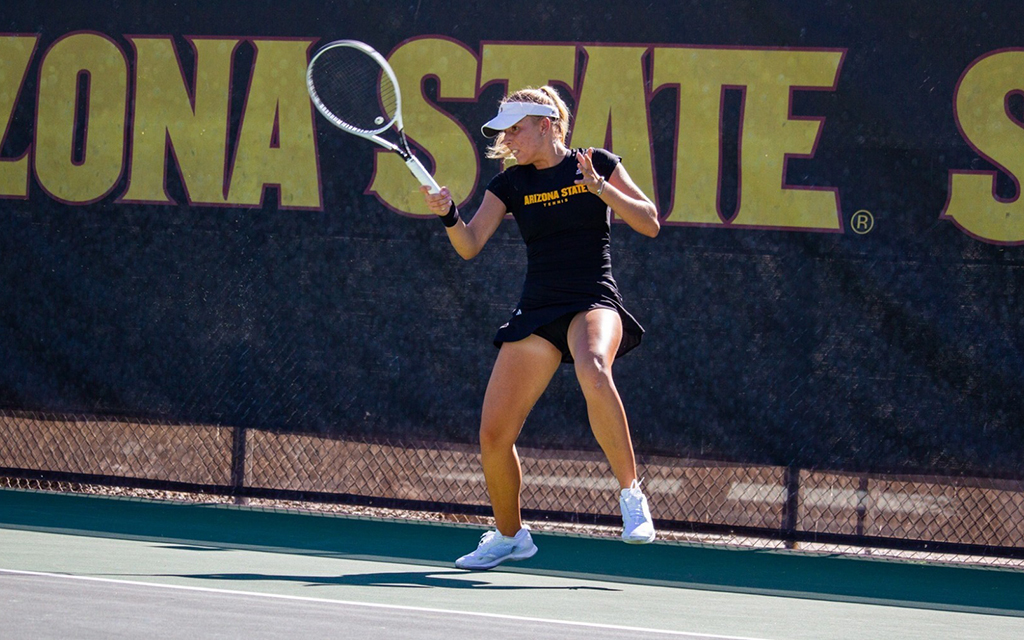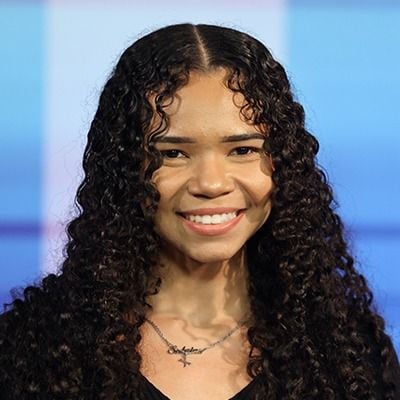
The ASU women’s tennis team, featuring talent from around the world, proves that diversity is its strength on and off the court. (Photo courtesy of Sun Devil Athletics)
PHOENIX – Marianna Argyrokastriti swam laps in a pool before she ever stepped onto a tennis court. It wasn’t until she was waiting for her sister to finish swimming practice that she discovered tennis racquets in the back of the car, and since the age of 6, it’s all she’s known.
At first, due to an injury, Argyrokastriti wasn’t looking to come to the United States to be a college athlete. Rather, she was planning on playing professionally soon after she recovered. However, after being recruited by multiple college coaches and visiting different schools in the states, her mindset changed.
After traveling over 6,000 miles from her hometown of Athens, Greece, to The Valley, Argyrokastriti felt that Arizona State University stood in a league of its own and felt the most homey.
In her senior year at ASU, she has singles and doubles career records of 40-14 and 19-13, respectively. During her junior year, she won 16 of her first 17 matches. But she’s not the only international player making an impact on the team and for ASU’s athletics program, which consistently recruits athletes from outside the US borders.
With over 12,000 international students, ASU welcomes students from all over the world to find a home within The Valley. Some students might think it’s unfathomable to travel thousands of miles and move across the world for their education, but for others, it’s something they don’t think twice about.
During the 2022-23 academic year, ASU stands as the leading institution to hold the most international students within Arizona and is the nation’s No. 1 public institution in which international students choose to attend.
Within the 26 sports that ASU offers, 94 of its 650 athletes trek thousands of miles to make the most out of their athleticism and education. Athletes departed from 35 different countries, including Australia, Croatia, Czech Republic, England, France, Greece, Hungary, Turkey and Switzerland, to find their new home away from home in the desert.
ASU women’s tennis team is one of the sports that stands out with eight of its nine players being international students, as the team’s makeup of foreign students is 88%. The women on the team arrived from Greece, Switzerland, Canada, France, Latvia, Poland, Croatia and Lithuania.
Picking up the tennis racquet
Junior Patricija Spaka picked up her first racquet at 5 years old and hasn’t put it down since. Her hometown of Liepaja, Latvia, embraces the sport and fields plenty of tennis courts. Spaka was around 10 years old when she realized she didn’t want to play tennis just as a hobby anymore, but professionally.
Soon enough she was playing international tennis tournaments and would visit the U.S. frequently for matches and to visit college campuses.
Most of the women’s tennis team was introduced to tennis through their family. Freshman Emilija Tverijonaite, from Siauliai, Lithuania, started playing at 4 years old, taking after her parents and two older brothers.
Freshman Sara Svetac began playing at age 6, following in the footsteps of her grandfather and mom, who used to play together constantly.
“When I was little I was running around the court,” Svetac said. “And then they were like, ‘Let’s try to put you in tennis school.’”
Svetac instantly fell in love with the game and has been playing ever since.
Senior Giulia Morlet, from Paris, France, started playing tennis simply because her brother played, and whatever he did, she wanted to do. As a young 4-year-old, she would hit balls in the squash court while her brother and dad played tennis. When she got older and started taking the game seriously, she soon realized that she was an above-average player.
The French Tennis Federation, a governing body for tennis in France, observed Morlet playing and soon enough the sport became an extensive part of her life.

ASU women’s tennis freshman Sara Svetac, from Split, Croatia, follows in her family’s footsteps and showcases her passion for the game that started at age 6. (Photo courtesy of Sun Devil Athletics)
A home away from home
Spaka and Morlet’s recruiting process was different than they may have expected due to COVID-19 lockdowns making it difficult to travel to other countries.
At the age of 12, Spaka had the chance to come to the U.S. to play in tournaments, and during her trip she visited a few colleges in Florida. Soon she realized that going to college was something she wanted to do.
“That was when I really started to focus on college and coming here,” Spaka said. “Back when I was 12, I just did whatever it took to get here.”
Four years later, she began looking seriously into different universities as coaches started reaching out to her to talk about the various opportunities in the U.S. The challenge for Spaka was being unsure about what factors to look for when trying to find a university to attend. And because of COVID-19 protocols, she was not able to visit any colleges, making it a “blind shot” for her decision-making.
Luckily, the conversations and connection she had with ASU associate head coach Matt Langley aided in her landing at ASU. She felt supported by the coaches, she was familiar with some of the girls on the team and the weather in Arizona simply couldn’t be beat.
For Morlet, she began to feel lost before coming to ASU, and it didn’t help that these feelings occurred at the beginning of COVID-19. Living in France, her love for the sport had started to fade and she knew she needed to change her routine.
While checking her Instagram direct messages, she noticed that Langley had messaged her about coming to ASU and she thought, “Why not?” She wanted to change her mindset and hoped ASU could be the answer.
Sheila McInerney, ASU women’s tennis head coach of 39 years, said that recruiting American athletes is the priority, but it can be difficult. Every summer there are four tournaments the coaches attend to recruit players – The Clay Courts, The Winter Nationals, The Fed Cup and The Nationals. But with many athletes choosing Ivy League schools and other programs such as Stanford, USC, Cal, Duke and North Carolina recruit their players, the options for American players start to become slim.
“If you want to compete, you want to get the best players,” McInerney said. “And for us right now it’s the international kids that we have the best chance to get the good ones.”
McInerney gives credit to Langley for finding talented athletes overseas. She also credits the agencies that help international kids find a college to attend.
“They (international athletes) really appreciate the experience here,” McInerney said. “Because over in their countries you either go on to college or you turn professional. So they don’t have the opportunity to do both – play tennis and go to school – so it works out well.”
The challenges of living overseas
Although being a college athlete in America presents multiple opportunities, it doesn’t come without the hardships of living in a different country.
Being away from family and friends, missing out on birthdays and holidays, and not being a one-hour flight away from their home country can be tough. The team gets the chance to go home only twice a year – winter break and summer break.
Spaka traveled frequently when she was younger, which helped her gain more independence. And in the past, when she traveled around the world, being far from home didn’t affect her. Moving to the U.S., however, was surprisingly a big shock for her mental health and her body.
“When I came here, like after a month it hit me,” Spaka said. “I was like, ‘Yeah I really want to go home.’ Like I feel homesick and it was hard. Mentally probably was the hardest because I felt like there’s a lot of things changing around me, so I wasn’t sure what to expect. So that’s when I started to understand like (homesickness) is a big thing, like it’s hard to be away from my parents.”
Spaka said the first semester of being away from home proved to be the most difficult adjustment period, but she got used to it as time went on.
“You go home for winter break and it just helps,” Spaka said. “Because every single time when you go home it feels like the best feeling ever. But then I kind of miss the things that are here. I miss my team and the home. It’s just like you miss a lot when you’re here and you also miss when you’re home.”
For most of the women on the team, living away from home has been a constant in their lives since adolescence.
“I mean it’s tough (being away from family and friends),” Argyrokastriti said. “It’s tougher sometimes more than others to be honest. I’ve been living abroad since I was 15 because I was training in Belgium alone in an academy there.
“So it’s hard, but then again, I’ve adjusted to it. I’m kind of used to it and I just know that I’m here for something bigger, so it’s a sacrifice which is worth it right now.”
Morlet has traveled since she was 13 years old for tennis tournaments, but since she took flights with her dad, she maintained a family aspect – something she doesn’t have in Arizona.
“When I got here, it was a completely new experience,” Morlet said. “Living on my own, making my own decisions, I just discovered myself even more because I was more independent.”
Tverijonaite was nervous about being away from her family and being alone before coming to ASU. But her busy schedule with school, practice and tournaments doesn’t leave her much time to ponder on it.
Being far from home isn’t the only thing these athletes have to endure, but also the culture differences between America and their home countries.
“The culture is so different,” Argyrokastriti said. “The people, the way they communicate, the way they are, the foods so different. Even activities, entertainment, the way the cities are built, like open spaces, lots of roads and parking lots and malls. It’s just something so different, you get used to (it) though.”
Morlet said the biggest adjustment she’s had to make is eating the food in the U.S. compared to Paris, France. She also noted that French people are more straightforward compared to Americans.
Being an international athlete can be challenging at times, but being on the team is worth it for the women – especially because it is only four years of their lives.
Morlet said all the new experiences and memories she has made are worth being away from a home for a few years. She gets to discover new cultures and be around people from all over the world. She tries to get the most out of her four years at ASU and live the full experience.
McInerney said the team gets along great and their chemistry makes her job much easier.
“It’s an insane opportunity,” Argyokastriti said. “And talking to people at home, seeing people at home, they don’t have this – the facilities, the education, the people. I don’t think I will ever be able to have something like this anywhere else in the world. I think it’s worth sacrificing a little bit of time with my family and my country.”

